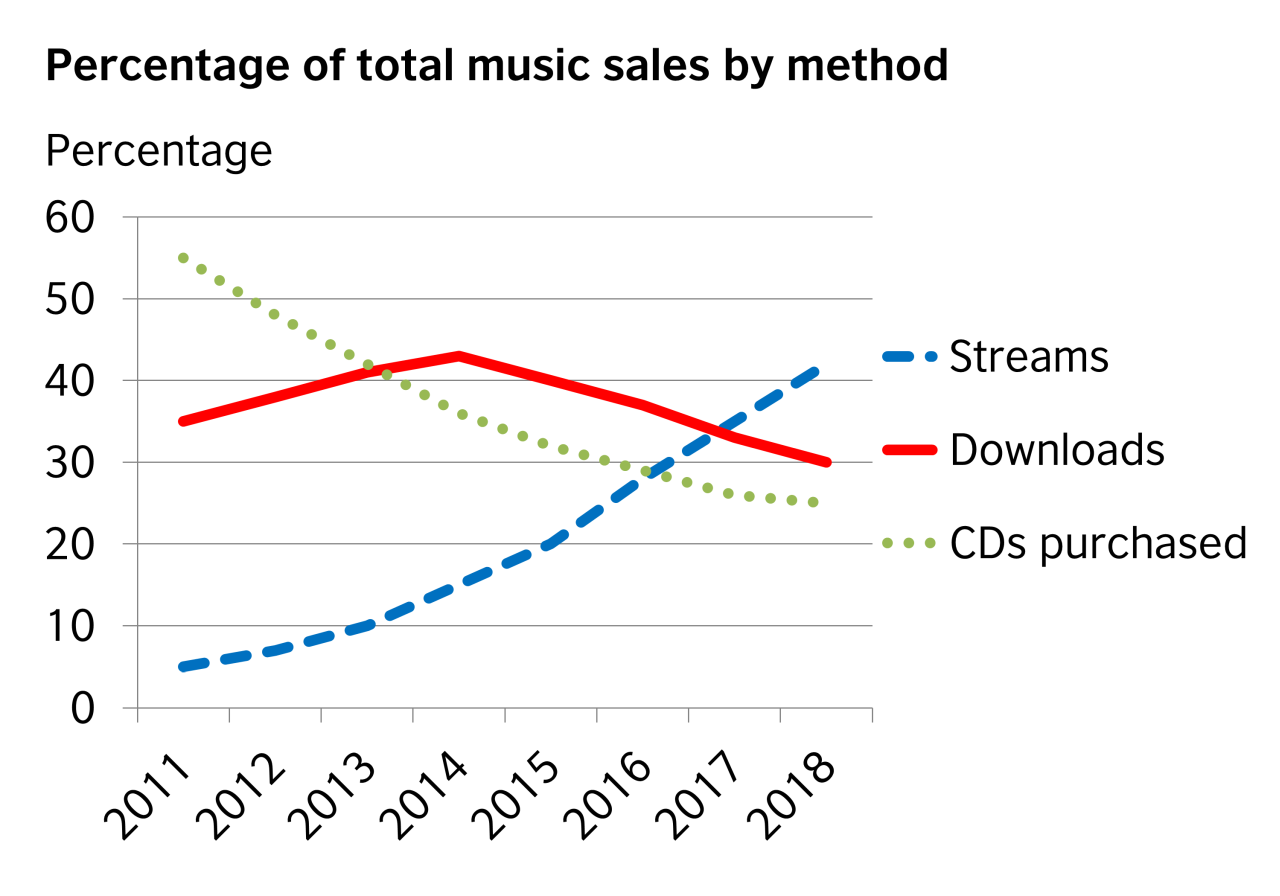
Do the preparation task first. Then read the text and tips and do the exercises.
Preparation
The graph below shows how people buy music. Summarise the information by selecting and reporting the main features, and make comparisons where relevant.

The graph illustrates trends in music buying habits between 2011 and 2018. It presents three different methods: streaming, downloading and buying CDs.
Overall, both downloads and physical sales of music have steadily declined. The latter has slumped since 2011, while the downturn for the former began in 2014. However, there has been a sharp rise in people streaming music since 2013.
In 2011, the majority of music sales were of CDs, at 55% of all sales. In contrast, streaming was not common at all at only 5%. Also, although people had started to download music, it only represented 35% of sales. As sales of CDs began to fall, downloads started to rise. They rose steadily and downloads overtook physical sales in mid-2013. During the same period, streaming doubled to 10% but then it started to grow more dramatically.
Downloads peaked in 2014 at about 43% of sales but fell to 30% by 2018. This was slightly higher than physical sales, which shrank to 25%. Streaming, on the other hand, overtook both of them and accounted for just over 40% of sales in 2018.
Please note: This page was designed for writing practice only. Information in the graph may not be accurate.
Tips
- Change the words in the question to introduce your answer, e.g. This graph shows = This graph illustrates.
- The second paragraph should give an overview of the main points the graph shows (imagine you're describing the results to someone who can't see the graph).
- The following paragraphs should describe the main patterns or trends in more detail.
- Use precise vocabulary like steadily declined and a sharp increase to describe trends. Use linking expressions like while and in contrast to make comparisons.
- The question asks you only to 'Summarise the information'. Don't give reasons why these trends might have occurred, or your personal preferences on the topic.




Hi Razan Mahairy,
That's great :) Try using a notebook, and let us know if it works for you or if you find any other good ways to learn vocabulary.
Best wishes,
Jonathan
The LearnEnglish Team
Hello mxoubi0,
Mostly, this is just how we speak about these numbers. We use 'fall to' + a number to speak about a decrease in a value, not just percentages. If you follow the link and perform a search on that page for 'fell to', you will multiple examples of this and other uses.
One of the common meanings of 'by' is to indicate 'before' -- follow the link and look for entry 1.8. 'just over' means 'a little bit more than', so the number here could be, for example, 41 or 42%.
All the best,
Kirk
The LearnEnglish Team
Hello mxoubi0,
In this sentence has been is a present perfect form. One use of the present perfect is to describe events which began in the past and continue up to the present. The phrase since 2013 has this meaning, so the present perfect is used.
Had been would be a past perfect form. It would be used to describe an action before another action in the past.
You can read more about the present perfect here.
You can read more about the present perfect here.
Peter
The LearnEnglish Team